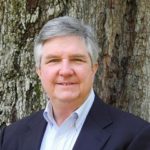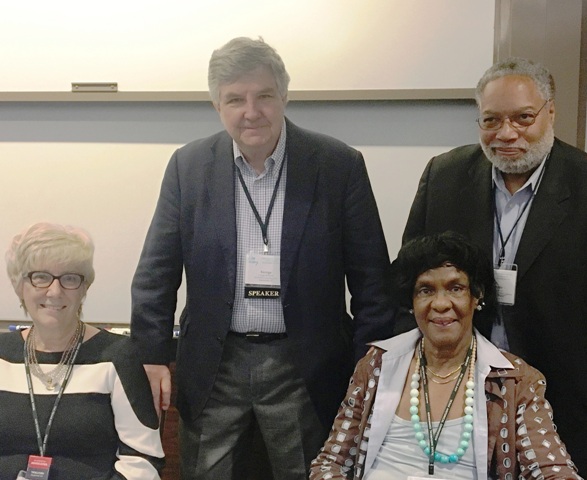Mother Emanuel AME, Charleston, SC
AASLH Conference, Austin, Texas – September 8, 2017
by George W. McDaniel
I have just returned from the annual conference of the American Association for State and Local History in Austin, Texas. I left on September 6 and cut my trip short, flying back the night of September 8 due to the uncertain trajectory of Hurricane Irma. I saw a number of old friends, and it was great to make new ones.
I had organized a session for Friday morning, entitled “Commemorating Tragedy, Healing Wounds”, which marked the first session of its kind for an AASLH conference. Joining me was Elizabeth Alston, a trustee and long-time member of Mother Emanuel; after the tragic massacre, she became chairman of Emanuel’s Memorabilia Sub-Committee, and I vice-chairman. Also with us was Carol Poplin, director of HW Exhibits in Mt. Pleasant, and the designer and producer of the two exhibits of memorabilia produced as part of Emanuel’s commemorative anniversary program. Toni Carrier, director of the Family History Center of the International African American Museum, who had worked hard on the preservation of digital responses to the tragedy, could not join us since she lives in Tampa and was in Irma’s path.
Before we presented, we had an enjoyable conversation with Lonnie Bunch, director of the National Museum of African American History and Culture. Afterwards, he said our session was “among the most powerful I’ve been to.” What struck everyone, I think, was our message that such a tragedy could happen in their community, and if history be a guide, it will come by surprise, so they need to get prepared now by engaging their community and getting their leadership thinking about how their organization should respond. Also, what their organization can do now to minimize, if not prevent, such violence by building understanding, empathy, and tolerance. For when a tragedy strikes, as we learned, it takes a toll, both professional and personal. Thus, the need for preparation.
Our presentation was filmed in nine segments – for all segments, click here: AASLH 2017 Conference – Commemorating Tragedy, Healing Wounds
Segments 1 and 2: As our presentation got underway, I introduced the topic by asking simple questions:
When violent tragedies strike communities, how should history organizations respond? They expose deep divides in our social fabric, and often, as at Emanuel AME, the Pulse night club in Orlando, and elsewhere, catch history organizations by surprise. While many organizations remain uninvolved, everyday citizens from throughout the community and nation express their grief, sympathies, and hopes by coming to the site and remembering, praying, and fellowshipping. They endow objects with their feelings and leave them as memorials. They send letters and gifts by mail and communicate by social media.
Do such expressions warrant preservation, and if so, how and by whom? If history organizations do step forward, how can their efforts help the public to see history organizations as both anchors and visionaries, capable of turning such tragedies, which are inherently obstacles and dividers, into opportunities to engender healing and to build a better future?
I explained that while such questions are new to the field, they are critical to our future. After the mass murders in Charleston, we had to deal with practical issues involving leadership, authority, staffing, curation, funding, exhibiting, and public outreach. Such tragedies will, unfortunately, happen again, so our goal was to spark dialogue and communicate the need for a a planning process among history organizations across the nation.
Segments 2, 3 and 4: As a member of the targeted group, Elizabeth Alston offered a deeply personal perspective. She had been long-time friends with each of the victims and survivors. This was no abstraction to her. Her feelings are still raw. In the video of the session, I hope you will fast forward to her thoughts and reflections during her presentation and also during the question and answer section, for it is vital that we hear from the aggrieved group. While any of us can read about such an occasion, we are not of it, and their personal perspectives and experiences need to be heard and taken to heart. One of the questions posed by a member of the audience was “How do you cope with people coping?” Referencing her training years ago in civil rights, Liz replied: “Life prepares you for the duties of today.”
Our presentation was filmed in nine segments – for all segments, click here: AASLH 2017 Conference – Commemorating Tragedy, Healing Wounds
Segments 4, 5, 6: Carol Poplin gave a deeply felt presentation about the two exhibits she designed for Mother Emanuel’s two commemorative programs. She spoke candidly about the challenges of funding, leadership, timing, and expectations. At the same time, she articulated clearly the higher cause that motivated her and her staff and the feelings that producing the exhibit of memorabilia generated. From time to time, she said, as she and staff worked with the quilts, artwork, poems, sculpture, and personal artifacts people sent to the church or left in front, they would have to step outside and re-gain their composure. She was touched by how people wished to endow things with their spirit and offer them up to the church in ways reminiscent of what people have been doing at shrines for millennia. She felt linked to the human continuum.
Segments 7 and 8: Our hopes for the session were that the audience could learn personally from the point of view of a member of the targeted group – how it felt to experience hate-filled and violent tragedy, and how that group responded to outreach from other organizations.and individuals. We also hoped to initiate dialogue about the need for further discussion and planning among historical organizations at the local, state, and national levels as soon as possible in response to community trauma and tragedies.
Segment 9: George McDaniel and Elizabeth Alston – Last, while Emanuel may have become well known for forgiveness, that is a fraught concept and often not achievable for many, as Elizabeth Alston explained. We know that healing after violent tragedies is a long and complicated process, and yet organizations like ours – through community outreach and dialogue, commemorations and exhibitions – can play a much-needed role in recognizing the dark side of our history as well as the light, to engender healing in others while seeking to heal ourselves.

Audience members asked thought-provoking questions.
 George W. McDaniel, Ph.D., is President of McDaniel Consulting, LLC, a strategy firm that helps organizations use history to build bridges within itself and to its broader constituents. The company’s tag line, “Building Bridges through History,” is grounded in McDaniel’s personal beliefs and his experience in site management, preservation, education, board development, fundraising, and community outreach. Rather than using history to divide us, he strives to help organizations use history, especially local history, to enhance cross-cultural understanding and to support local museums, preservation, and education. Dr. McDaniel recently led volunteer efforts with Emanuel AME Church and historical organizations in Charleston to use historic preservation to enhance racial reconciliation and healing.
George W. McDaniel, Ph.D., is President of McDaniel Consulting, LLC, a strategy firm that helps organizations use history to build bridges within itself and to its broader constituents. The company’s tag line, “Building Bridges through History,” is grounded in McDaniel’s personal beliefs and his experience in site management, preservation, education, board development, fundraising, and community outreach. Rather than using history to divide us, he strives to help organizations use history, especially local history, to enhance cross-cultural understanding and to support local museums, preservation, and education. Dr. McDaniel recently led volunteer efforts with Emanuel AME Church and historical organizations in Charleston to use historic preservation to enhance racial reconciliation and healing.
McDaniel is also the Executive Director Emeritus of Drayton Hall, a historic site in Charleston, SC, owned by the National Trust for Historic Preservation. He retired from Drayton Hall in 2015 after 25 years of distinguished service.
Header Image: L-R: Carol Poplin, director of HW Exhibits, George McDaniel, Elizabeth Alston, a trustee and long-time member of Mother Emanuel AME, and Lonnie Bunch, director of the National Museum of African American History and Culture. Not shown: Toni Carrier, director of the Family History Center of the International African American Museum

 McDaniel Consulting LLC is a strategy firm that helps organizations use history to build bridges within itself and its broader constituents.
McDaniel Consulting LLC is a strategy firm that helps organizations use history to build bridges within itself and its broader constituents.